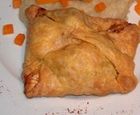|
Mid-East Appetizer Savory Meat Pies These delicious little meat pockets are easier to make then they seem. You just need time for the dough to rise.
Dough: combine water, yeast, and sugar in a large bowl. Beat in only 2 C flour, along with salt and oil. Let rest 10 minutes; then stir in enough of the remaining flour to make a soft dough. Knead dough, folding and pushing down with the heel of your hands, till you get a smooth and elastic texture. Let the dough rise in a warm place till double in bulk. Punch the dough down and shape into 16 balls. Allow the balls to stand in a warm place till double in size. Filling: saute onions in oil till soft and translucent, about 7-10 minutes. Add garlic, cooking 2 more minutes. Add remaining ingredients but don't cook (the filling cooks in the rolls as they bake). Assembly: preheat oven to 425. On a floured surface, roll the 16 raised dough balls into 4” circles, and brush the edges with egg yolk. Spoon 2 T (heaping) into center of each circle, bring edges up to meet one another, and pinching together to make a little pouch. Let rise for another 30 minutes and bake (pinched side up) on a greased baking sheet for 30 minutes, till golden brown. |
Tips & Glossary Many of the ingredients used for Middle-Eastern cooking may not be in your spice shelf, but you can find them at Mid-Eastern food stores. So to avoid frustration, make a list of the items you need before trying out the recipes. Toss any old, even unopened, spice jars because they’ve probably lost their distinctive flavors. Put them on your shopping list. Bulgur Wheat: wheat grains that have been par-boiled, dried, and de-branned. Bulgur has a high fiber content and wonderfully nutty flavor. Cardamom: related to ginger. Pods (green, brown, or black) are the best way to store the spice, although high-quality ground is readily available. A equivalency: 10 pods = 1½ tsp. ground cardamom. Coriander: aka cilantro, Chinese, or Mexican parsley. Fresh leaves and dried ground seeds are used in Mid-East, Asian, Indian, and Mexican cuisines. Cumin: related to parsley and carrot plant; an important ingredient in chili powder. Used especially in curries, but also in Mid-Eastern, Mexican and Asian dishes. Cumom has an earthy, peppery flavor. Deep Frying: oil must be hot enough; otherwise food will be soggy and greasy. Use a deep-fry thermometer to ensure proper temperature is reached. When cool, oil can be strained, refrigerated, and re-used. Filo: aka phyllo; paper-thin sheets of raw, unleavened flour dough. Purchase frozen in any grocery store and follow directions on package for thawing. When working with one sheet, keep others covered with a damp towel to prevent drying out. Rosewater: distilled from rose petals and used to flavor Mid-Eastern and Asian cooking. You can make your own—but why? Purchase it at Asian or Middle Eastern food stores. Semolina flour: made from hardy durum wheat. A yellowish flour, it's used in Asian and Mid-East cooking (couscous). In the U.S., it's Farina, a breakfast cereal. Tahini: paste from ground, hulled sesame seeds. A major ingredient in hummus and other Mid-Eastern and Asian foods, you can purchase at most grocery stores.
|
Site by BOOM
![]()
LitLovers © 2024

